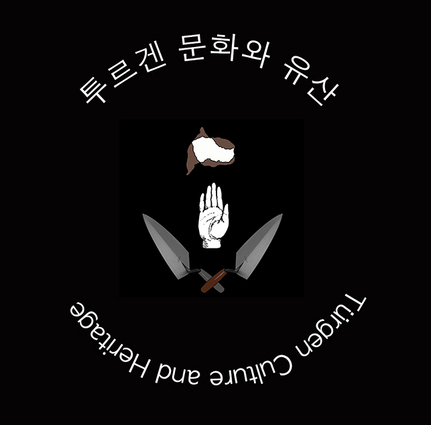turgen culture and heritage

Türgen Culture and Heritage was a makeshift museum for a fictitious community, temporarily hosted within Studio 10 at Seoul Art Space Geumcheon. The space was composed of archival materials relating to the Türgen clan. A documentary video and displays of national flags, historical artefacts, and maps overlapping Istanbul and Seoul’s city walls, demonstrated the culture and migration trails of the community during a 400 year period. The museum exemplified an interior of a gecekondu, and featured an indigenous clan member serving soup to visitors in their traditional Türgen outfit.
The video features several interviews I conducted with the labourers of the Seoul Art Space in which I was based; the cleaning lady and security guards – disguised as members of the hybrid Türgen clan. Throughout this docu-fiction the ‘clan members’ provide information about Türgens’ history, their contemporary, adaptive living conditions in another country, their traditions and their personalised topography, expressed in hand-drawn maps of permitted migration trails.
Having been a nomadic society that migrated from Istanbul to Seoul at the beginning of the 18th century, the Türgen clan based their customs and their livelihood on temporary construction work that has rendered them as ‘urban nomads’. Their residence is in unplanned, transitional houses called ‘gecekondu’s, which are built overnight and are often destined for demolition by local authorities.
In reality, the term gecekondu takes its roots from the mass migration of people from villages to large cities – especially to Istanbul during the 1950’s – in the hope of finding work, mostly in construction. These Turkish shantytowns in big cities have always been accepted as the ‘dirt’ by authorities and class-conscious residents, who would wish them to be erased from the landscape at once. The communities that live in gecekondus have faced immense discrimination in these metropolises, encountering social alienation both here and in their homeland.
I recontextualised this 20th century phenomenon with a circumstance of the Ottoman Empire, in which nomad communities of the time were forced to settle in order to facilitate the Sultan’s control of land. Therefore, according to my narrative, the Türgen clan have historically lived in ramshackle brick houses in the cities, rather than the typical yurt-like tents upon the mountains. Two realities from two very different eras in Turkish history had been shuffled.
Special thanks to Altai Kai for their generosity and providing the original music for the soundtrack.
The video features several interviews I conducted with the labourers of the Seoul Art Space in which I was based; the cleaning lady and security guards – disguised as members of the hybrid Türgen clan. Throughout this docu-fiction the ‘clan members’ provide information about Türgens’ history, their contemporary, adaptive living conditions in another country, their traditions and their personalised topography, expressed in hand-drawn maps of permitted migration trails.
Having been a nomadic society that migrated from Istanbul to Seoul at the beginning of the 18th century, the Türgen clan based their customs and their livelihood on temporary construction work that has rendered them as ‘urban nomads’. Their residence is in unplanned, transitional houses called ‘gecekondu’s, which are built overnight and are often destined for demolition by local authorities.
In reality, the term gecekondu takes its roots from the mass migration of people from villages to large cities – especially to Istanbul during the 1950’s – in the hope of finding work, mostly in construction. These Turkish shantytowns in big cities have always been accepted as the ‘dirt’ by authorities and class-conscious residents, who would wish them to be erased from the landscape at once. The communities that live in gecekondus have faced immense discrimination in these metropolises, encountering social alienation both here and in their homeland.
I recontextualised this 20th century phenomenon with a circumstance of the Ottoman Empire, in which nomad communities of the time were forced to settle in order to facilitate the Sultan’s control of land. Therefore, according to my narrative, the Türgen clan have historically lived in ramshackle brick houses in the cities, rather than the typical yurt-like tents upon the mountains. Two realities from two very different eras in Turkish history had been shuffled.
Special thanks to Altai Kai for their generosity and providing the original music for the soundtrack.
